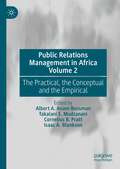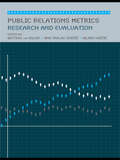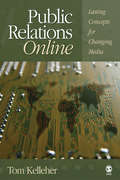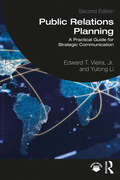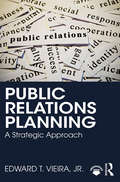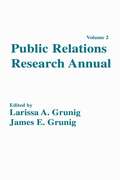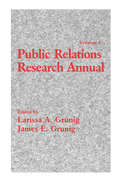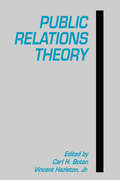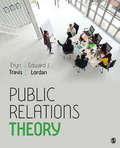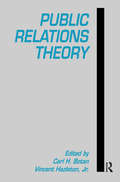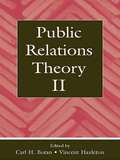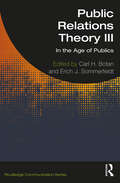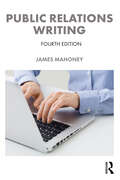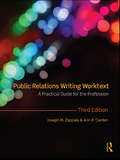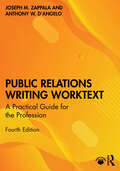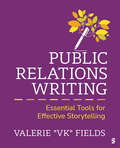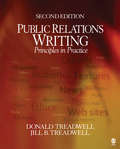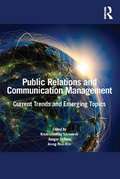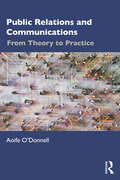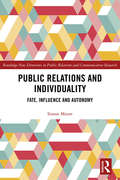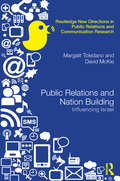- Table View
- List View
Public Relations Management in Africa Volume 2: The Practical, the Conceptual and the Empirical
by Cornelius B. Pratt Albert A. Anani-Bossman Takalani E. Mudzanani Isaac A. BlanksonThis two-part volume, the first of its kind, examines current pedagogical modules and research directions in public relations and communication management, identifying emerging issues driving the practice in Africa. In comparison to its Western and Asian counterparts, literature on public relations management in Africa is limited, and much of it is examined through the lenses of Western philosophies and pedagogies, failing to reflect Africa's socioeconomic, political, and cultural contexts. This project aims to change that. Albert Volume 2 brings together African scholars, moving beyond organizational impact to share the wider theoretical and practical perspectives on the practice of public relations on the continent, within its cultural, global, and technological milieu.Through conceptual discussions and empirical analyses, this volume shows how Africa is gradually coming out of the shadows of the Western world by building a body of knowledge the reflects the nature of public relations management on the continent. Chapters cover: how public relations contributes to strategic management in Africa; health communication and public relations management; strategic management of issues, as well as the implications of the fourth industrial revolution for public relations practice in Africa.
Public Relations Metrics: Research and Evaluation (Routledge Communication Series)
by Dejan Verčič Betteke Van Ruler Ana Tkalac VerčičResponding to the increasing need in academia and the public relations profession, this volume presents the current state of knowledge in public relations measurement and evaluation. The book brings together ideas and methods that can be used throughout the world, and scholars and practitioners from the United States, Europe, Asia, and Africa are represented.
Public Relations Online: Lasting Concepts for Changing Media
by Thomas A. KelleherRich in scholarly foundations combined with actual practice, Public Relations Online: Lasting Concepts for Changing Media connects the social and technological forces that are changing public relations. Using plain-talk discussion of theory and research, this book helps readers identify how lasting concepts for effective public relations can be applied in a changing media environment, and how a changing media environment affects the practice of effective public relations.Key Features:Provides "Hands-Online" activities: Internet resource exercises challenge readers to apply concepts to their world in "real-time" on the day that they read the chapter.Offers "Questionable Claims" boxes: Discussions present alternative perspectives on sometimes-over-hyped claims and serve to help sharpen critical-thinking skills.Discusses computer systems and networks: Server-side and peer-to-peer technologies are introduced as models for understanding online public relations.Focuses on how real people are using online media to communicate: Online public relations is more a matter of what people are doing with online media technologies than what these technologies are doing to people.Intended Audience:This text is designed for advanced undergraduate and graduate courses in Public Relations strategies and practices such as Public Relations Cases, Public Relations Management, Public Relations Strategy, and Public Relations Campaigns.
Public Relations Planning: A Practical Guide for Strategic Communication
by Edward T. Vieira, Jr. Yulong LiPublic Relations Planning: A Practical Guide for Strategic Communication provides students with an in-depth understanding of the steps involved in planning and executing a successful PR campaign. Taking a strategic approach to the subject, the authors bring years of practical experience to the project, helping students see how theoretical elements fit together in reality, and preparing them for the workplace. At the same time, the book goes beyond an introductory discussion of the theory of PR planning, incorporating material from cutting-edge research in the field.This fully updated second edition explores current trends and consequences surrounding the COVID-19 pandemic; covers the latest technological tools and techniques, as well as the ever-changing landscape of social media; and examines the role of data analytics in the PR decision-making process. Examples and vignettes have been updated so that they reflect the current state of the global PR environment, whilst learning objectives, key term definitions, and chapter exercises facilitate comprehension.Providing a solid foundation to the PR planning process, this text is core reading for advanced undergraduate, postgraduate, and executive education students studying Public Relations Strategy, Public Relations Campaigns, and Strategic Communications.Online resources include PowerPoint lecture slides, a test bank, answers for end-of-chapter questions, and instructor notes for the case studies.Public Relations Planning is featured on the International Public Relations Association website.
Public Relations Planning: A Strategic Approach
by Edward T. Vieira Jr.Public Relations Planning provides students with an in-depth understanding of the steps involved in planning and executing a successful PR campaign. Taking a strategic approach to the subject, the author brings years of practical experience to the project, helping students see how it all fits together in reality. The book goes beyond an introductory discussion of the theory of PR planning, incorporating material from cutting-edge research in the field. A discussion of the psychological aspects of communication, material on in-house/employee communication, as well as a chapter dedicated to discussing how social media strategies fit into a PR campaign, give students a real edge when it comes to executing an effective campaign. Plenty of global examples and a companion website featuring PowerPoint slides, a test bank, and answer key for end-of-chapter questions round out this excellent resource for students of public relations and corporate communication.
Public Relations Research Annual: Volume 1
by James E. Grunig Larissa A. GrunigThe first volume of this series features reviews of research programs, original research reports, and social scientific, historical, critical and humanistic methodologies.
Public Relations Research Annual: Volume 2
by Larissa A. GrunigThe purpose of this second volume is to challenge and extend the field of research in public relations. Taking a proactive approach to creating a stable, yet not stagnant annual, the editors directly solicited chapters on exciting and intriguing subjects. Assuming some prior knowledge, interests, and commitment of their readers, the editors hope that each chapter's report on original research provides enough context for understanding even if the area of inquiry is new to the readers.Public Relations Research Annual, Volume 2, continues to advance within the discipline beyond anecdotes to practical theories and research. Educators, practitioners, and researchers will find this annual's presentations and critiques useful in creating a systematic framework for their own endeavors.
Public Relations Research Annual: Volume 3
by James E. Grunig Larissa A. GrunigPublished in book form, this is a scholarly periodical of academic research in public relations, containing refereed reviews and reports of original studies. It follows the current trend toward more solidly grounded, theoretical research in a field that has only begun to mature. The studies and reviews presented represent the most contemporary thought and investigation brought to bear on this subject. Many relevant topics are discussed, including communication roles, women's issues in the feminization of the field, the concepts of symmetry and game theory, and finally, publics -- dealing with roles, risk takers, and how audiences receive, process, and retain messages on public policy issues.
Public Relations Theory
by Carl H. BotanBeginning with the basic premise that public relations can best be understood as a specialized type of communication, the contributors to this volume establish public relations as a vital and viable realm for communication research and theory development. Through the application of communication theories, they attempt to explain and predict public relations practices and then use these practices to develop communication theories. Their discussions fall into three distinct categories: metatheory, theory, and examples of applications of theories. An ideal volume for professionals and students in communication, journalism, and related fields.
Public Relations Theory
by Eryn S. Travis Edward J. LordanReflecting the ever-increasing changes in the public relations industry, this new text offers a fresh, up-to-date look at public relations theories as well as theories from related areas that impact public relations. Chapters move from the oldest areas of communication theory through newer models devoted to interpersonal, organizational, and mediated, up to the most current theories devoted to emerging media, including digital and social. Readers will learn how public relations and persuasion theories are at the heart of a practitioner’s day-to-day work, and see how a strong understanding of theories can make them more effective and strategic professionals.
Public Relations Theory
by Eryn S. Travis Edward J. LordanReflecting the ever-increasing changes in the public relations industry, this new text offers a fresh, up-to-date look at public relations theories as well as theories from related areas that impact public relations. Chapters move from the oldest areas of communication theory through newer models devoted to interpersonal, organizational, and mediated, up to the most current theories devoted to emerging media, including digital and social. Readers will learn how public relations and persuasion theories are at the heart of a practitioner’s day-to-day work, and see how a strong understanding of theories can make them more effective and strategic professionals.
Public Relations Theory (Routledge Communication Ser.)
by Carl H. Botan Vincent HazletonBeginning with the basic premise that public relations can best be understood as a specialized type of communication, the contributors to this volume establish public relations as a vital and viable realm for communication research and theory development. Through the application of communication theories, they attempt to explain and predict public relations practices and then use these practices to develop communication theories. Their discussions fall into three distinct categories: metatheory, theory, and examples of applications of theories. An ideal volume for professionals and students in communication, journalism, and related fields.
Public Relations Theory II (Routledge Communication Series)
by Carl H. Botan Vincent HazletonThe public relations landscape has changed dramatically from what it was in 1989, when the original Public Relations Theory volume was published. Reflecting the substantial shifts in the intervening years, Public Relations Theory II, while related to the first volume, is more a new work than a revision. Editors Carl H. Botan and Vincent Hazleton have brought together key theorists and scholars in public relations to articulate the current state of public relations theory, chronicling the ongoing evolution of public relations as a field of study. The contributors to this volume represent the key figures in the discipline, and their chapters articulate the significant advances in public relations theory and research.Working from the position that public relations is a theoretically grounded and research based discipline with the potential to bring numerous areas of applied communication together, Botan and Hazleton have developed this volume to open up the public relations field to a broad variety of theories. Organized into two major sections--Foundations, and Tools for Tomorrow--the volume presents four types of chapters: discussions addressing how public relations should be understood and practiced; examinations of theories from other areas applied to public relations; explorations of theories about a specific area of public relations practice; and considerations of public relations theories and research that have not been given sufficient attention in the past or that hold particular promise for the future of public relations. It serves as a thorough overview of the current state of theory in public relations scholarship. Like its predecessor, Public Relations Theory II will be influential in the future development of public relations theory. Taken as a whole, the chapters in this book will help readers develop their own sense of direction for public relations theory. Public Relations Theory II is an essential addition to the library of every public relations scholar, and is appropriate for use in advanced public relations theory coursework as well as for study and reference.
Public Relations Theory III: In the Age of Publics (Routledge Communication Series)
by Carl H. Botan Erich J. SommerfeldtThis important book chronicles, responds to, and advances the leading theories in the public relations discipline. Taking up the work begun by the books Public Relations Theory and Public Relations Theory II, this volume offers completely original material reflecting public relations as practiced today. It features contributions by leading public relations researchers from around the world who write about new developments in the field. Important subjects include: a turn to more humanistic, social, dialogic, and cocreational perspectives on public relations; changes in the capacity and use of new information technologies; a greater emphasis on non-Western international and intercultural public relations that considers an increasingly politically polarized culture; and issues of ethics that look beyond how clients and the traditional mass media are treated and into much broader questions of voice, agency, race, identity, and the economic and political status of publics. This book is a touchstone for advanced undergraduate and graduate courses in public relations theory and a key reference for researchers.
Public Relations Writing
by James MahoneyPublic Relations Writing is an undergraduate communication and public relations textbook. It positions writing for public relations in the context of strategic planning, and is based on traditional communication writing principles, including for news and digital media. The book illustrates how writing for all public relations tools reflects the concepts that inform professional planning and practice.This book, based on the author's wide professional practice and tertiary teaching experiences, has been widely used in international undergraduate teaching and learning. This fourth edition continues to treat clear, concise and accurate writing for this profession as integral to all aspects of professional practice and as a skill that is not confined to media release writing. Among the book's strengths are the student exercises, including international cases, which are based on real-world examples, and references to ethical practice. This book provides a holistic approach to learning about writing in this profession. While its focus is on writing, this holistic approach, which includes material on planning a communication strategy, makes it an ideal text for introductory subjects at university as well as for specialist writing units. While it is primarily grounded in Australian practice, the book is written in line with accepted international approaches to public relations writing, including the principles of journalism’s 'news writing', and contains case studies from other countries. This book appeals to audiences in early-year university students studying public relations and marketing communication.It is also suitable for professional practitioners seeking to enhance their writing skills.
Public Relations Writing Worktext: A Practical Guide for the Profession
by Ann R. Carden Joseph M. ZappalaPublic Relations Writing Worktext provides the fundamental knowledge and the basic preparation required for the professional practice of public relations writing. This textbook introduces readers to public relations and writing, providing an overview of the four-step public relations process in addition to defining and detailing the writing activities involved. It presents in-depth information on the writing formats and approaches used in implementing strategic public relations plans, and offers instruction for developing all types of writing assignments, starting with memos, proposals, and news releases, and moving on to the more complex tasks of advocacy writing, newsletters, crisis planning, and online communication. Examples accompany the discussions, providing guidance and structure for the varied writing activities. Retaining the approach of the second edition, this text incorporates numerous changes and updates, making it suitable for use as a primary course text. Updates include: increased focus on writing for the web, blogs, and electronic media, including information on writing social media releases and a new chapter entitled "New and Social Media" a new planning outline to help writers develop more effective messages expanded checklists for writers to reference when working on assignments additional examples of effective public relations writing by leading companies in a variety of organizational settings, including Mattel, UPS, Burger King, Sara Lee, Xerox, Frito-Lay, and many more new assignments based on topics, issues and problems that public relations professionals in all sectors face today restructured content for improved writing flow and consistency full instructor manual available at www.routledge.com/textbooks/zappala Authors Joseph M. Zappala and Ann R. Carden offer a clear and engaging introduction to the writing activities involved in public relations practice, resulting in a valuable resource for professionals as well as a practical classroom text for students planning careers in public relations.
Public Relations Writing Worktext: A Practical Guide for the Profession
by Joseph M. Zappala Anthony W. D’AngeloWith a concise approach that engages students and practitioners, this thoroughly updated fourth edition provides the fundamental knowledge and basic skill preparation required for the professional practice of public relations writing.Building on the strengths of previous editions, this edition focuses more closely on PR writing as a strategic function and on planning and content strategy design. With practical advice from PR professionals, it covers everything from day-to-day business communications and media tools to writing for social media and crisis situations.This fourth edition incorporates a number of changes and updates, including: New chapters on Social Media and Writing for Key Publics and new content on the use of generative AI and its impact on PR writing. Expanded chapters on Writing for Digital Communications and on Publications, Presentations, and Speeches. New guest columns from PR professionals on topics including writing and pitching the media, inclusive writing, speech writing. and measuring writing/content impact. New cases and assignments based on topics, issues, and problems that public relations professionals face today. The text is suitable for undergraduate and graduate students in a public relations writing course preparing for entry-level public relations and communications roles, as well as a useful reference for early-career practitioners.Online resources also accompany the book: teaching materials, test banks, and reference sources. Please visit www.routledge.com/9780367860028.
Public Relations Writing: Essential Tools for Effective Storytelling
by Valerie FieldsPublic Relations Writing: Essential Skills for Effective Storytelling is a step-by-step "how-to" guide that helps students develop and hone the skills they need to become strong writers and versatile storytellers within the Public Relations field. Author Valerie Fields uses a practical approach, providing students with tips and checklists for producing high-quality content. Sample templates, writing exercises, and case studies in each chapter give students the opportunity to analyze and craft strategic messages for specific audiences. With a focus on storytelling, social media, and socially-conscious content, this text helps students understand the power of words within the larger context of our ever-changing media landscape.
Public Relations Writing: Essential Tools for Effective Storytelling
by Valerie FieldsPublic Relations Writing: Essential Skills for Effective Storytelling is a step-by-step "how-to" guide that helps students develop and hone the skills they need to become strong writers and versatile storytellers within the Public Relations field. Author Valerie Fields uses a practical approach, providing students with tips and checklists for producing high-quality content. Sample templates, writing exercises, and case studies in each chapter give students the opportunity to analyze and craft strategic messages for specific audiences. With a focus on storytelling, social media, and socially-conscious content, this text helps students understand the power of words within the larger context of our ever-changing media landscape.
Public Relations Writing: Principles in Practice
by Donald F. Treadwell Jill B. TreadwellPublic Relations Writing: Principles in Practice is a comprehensive core text that guides students from the most basic foundations of public relations writing-research, planning, ethics, organizational culture, law, and design-through the production of actual, effective public relations materials. The Second Edition focuses on identifying and writing public relations messages and examines how public relations messages differ from other messages.
Public Relations and Communication Management: Current Trends and Emerging Topics (Routledge Communication Ser.)
by Ansgar Zerfass Jeong-Nam Kim Krishnamurthy SrirameshPublic Relations and Communication Management serves as a festschrift honoring the work of public relations scholars James E. Gruning and Larissa A. Grunig. Between them, the Grunigs have published 12 books and more than 330 articles, book chapters, and various academic and professional publications, and have supervised 34 doctoral dissertations and 105 master’s theses. This volume recognizes the Grunig‘s contributions to public relations scholarship over the past four decades. To honor the Grunig’s scholarship, this volume continues to expand their body of work with essays from renowned colleagues, former students, and research associates. The chapters discuss current trends in the field as well as emerging issues that drive the field forward. Sample topics include theories and future aspects of the behavioral, strategic management approach to managing public relations, and its linkages and implications to related subfields and key field issues. Contributions stimulate academic discussion and demonstrate the relevance of applied theories for the practice of public relations and communication management with up-to-date concepts, theories, and thoughts.
Public Relations and Communications: From Theory to Practice
by Aoife O'DonnellThis book provides an introduction to public relations (PR) that employs pedagogical experiential learning models to assist students in developing the skills and competencies required by the PR industry. The book takes the reader on a journey from the theory and origins of PR, through to the structure of the PR profession and the more practical elements of how PR is practiced today. It devotes attention to the common competencies necessary for success as a communications professional, such as communication skills, critical thinking skills and business acumen, while giving due focus to the rapidly evolving new technologies and media that impact how organisations communicate. Featuring example cases from around the world, each chapter includes discussion topics and scenario-based questionnaires to encourage learning and assist students in developing key competencies. This book is ideal for undergraduate PR modules, particularly those with experiential and/or blended learning pedagogical approaches. It will also be useful to those in business seeking to gain a deeper understanding of communications. Situational Judgement Tests and sample press releases, presented as online resources, also accompany the book. Please visit www.routledge.com/9781032170435.
Public Relations and Communications: From Theory to Practice
by Aoife O'DonnellThis book provides an introduction to public relations (PR) that employs pedagogical experiential learning models to assist students in developing the skills and competencies required by the PR industry.The book takes the reader on a journey from the theory and origins of PR, through to the structure of the PR profession and the more practical elements of how PR is practiced today. It devotes attention to the common competencies necessary for success as a communications professional, such as communication skills, critical thinking skills and business acumen, while giving due focus to the rapidly evolving new technologies and media that impact how organisations communicate. Featuring example cases from around the world, each chapter includes discussion topics and scenario-based questionnaires to encourage learning and assist students in developing key competencies.This book is ideal for undergraduate PR modules, particularly those with experiential and/or blended learning pedagogical approaches. It will also be useful to those in business seeking to gain a deeper understanding of communications.Situational Judgement Tests and sample press releases, presented as online resources, also accompany the book. Please visit www.routledge.com/9781032170435.
Public Relations and Individuality: Fate, Influence and Autonomy (Routledge New Directions In Public Relations And Communication Research Ser.)
by Simon MooreOur individuality is partly shaped by encounters with the external world so it is inconceivable that we are unaffected by the planned management of public communications which manages much of our external experience. Exploring one of the most important mediators between organizations and individual encounters – public relations (PR) – is long overdue. By developing new ways to create and connect with us as members of particular target audiences, has it changed our interior existence by altering perceptions of the world outside ourselves? PR’s massive impact on groups, society or organizations is rightly explored, but its immense influence on our individuality is neglected. In an age where new media makes deepening connections to individuals, the relationship of PR to individuality is one of the field’s most profoundly important issues. This provocative book will assist scholars and advanced students in PR and communication research to develop a clear, structured, disciplined understanding of this phenomenon and its implications.
Public Relations and Nation Building: Influencing Israel (Routledge New Directions in PR & Communication Research)
by David McKie Margalit ToledanoAll public relations emerges from particular environments, but the specific conditions of Israel offer an exceptional study of the accelerators and inhibitors of professional development in the history of a nation. Documenting and analyzing the contribution of one profession to building one specific nation, this book tells the previously-untold story of Israeli public relations practitioners. It illustrates their often-unseen, often-unacknowledged and often-strategic shaping of the events, narratives and symbols of Israel over time and their promotion of Israel to the world. It links the profession’s genesis – including the role of the Diaspora and early Zionist activists – to today’s private and public sector professionals by identifying their roots in Israel’s cultural, economic, media, political, and social systems. It reveals how professional communicators and leaders nurtured and valued collectivism, high consensus, solidarity, and unity over democracy and free speech. It investigates such key underpinning concepts as Hasbara and criticizes non-democratic and sometimes unethical propaganda practices. It highlights unprecedented fundraising and lobbying campaigns that forged Israeli identity internally and internationally. In situating Israeli ideas on democracy in the context of contemporary public relations theory, Public Relations and Nation Building seeks to point ways forward for that theory, for Israel and for the public relations of many other nations.
